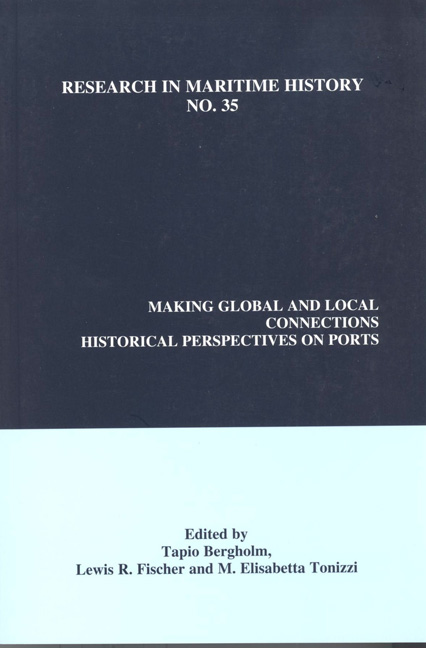Book contents
- Frontmatter
- Contents
- Contributors' Notes
- Contributors
- “Introduction”
- Part I Port Case Studies
- “The International Scope of Bordeaux Port: Logistics, Economic Effects and Business Cycles in the Nineteenth and Twentieth Centuries”
- “The Lancashire Cotton Lobby and the Making of the Manchester Ship Canal from 1883 to the Interwar Period”
- “Mormugao Port: The Golden Gateway to Goa”
- “New Perspectives on Port Competition: Antwerp and Rotterdam, 1945-1975”
- “The Environmental Impact of Ports: An Australian Case Study”
- “A Survey of the Operations of the Port of Kaohsiung, 1949-1957: The Policies for Survival?”
- Part II Port Systems
“Mormugao Port: The Golden Gateway to Goa”
from Part I - Port Case Studies
- Frontmatter
- Contents
- Contributors' Notes
- Contributors
- “Introduction”
- Part I Port Case Studies
- “The International Scope of Bordeaux Port: Logistics, Economic Effects and Business Cycles in the Nineteenth and Twentieth Centuries”
- “The Lancashire Cotton Lobby and the Making of the Manchester Ship Canal from 1883 to the Interwar Period”
- “Mormugao Port: The Golden Gateway to Goa”
- “New Perspectives on Port Competition: Antwerp and Rotterdam, 1945-1975”
- “The Environmental Impact of Ports: An Australian Case Study”
- “A Survey of the Operations of the Port of Kaohsiung, 1949-1957: The Policies for Survival?”
- Part II Port Systems
Summary
Introduction
Ports are engines for the economies they serve. The development of modern ports is the result of a variety of factors. This essay focuses on some of the variables which have contributed to the success and development of the modern port of Mormugao, the “golden gateway” to Goa. Some of the factors behind the growth of Mormugao are clear. First, Goa is endowed with many mineral resources, especially iron ore in the hinterland, which was discovered in the 1950s by private entrepreneurs. Second, this port on the west coast of India is strategically located to cater for the traffic not only of Goa but also of the neighbouring states and indeed the world. Finally, since the port achieved its greatest success after the establishment of the Port Trust in 1963, it is obvious that this form of organisation has enabled Mormugao to function well. The growth of the port continues in the era of increased globalisation and heightened competition. Indeed, it is even taking part in the container revolution.
Goa has a rich heritage. It was referred to in ancient Hindu mythology and has been ruled by many dynasties, such as the Bhojas, Konkan Mauryas, Goan Silharas, Kadambas and Vijaynagaras. Empires rose and fell in Goa, but in its long history the port city of Goa, and later the port of Mormugao, has withstood the test of time. The origin of the modern port, however, derives from the Treaty of Lisbon signed in 1878 between Britain and Portugal.
Goa, the twenty-fifth state of the union of India, is a tiny, scenic place which has been variously known as the “Tropical Paradise of Tourists,” “Golden Gateway of Commerce and Trade,” “Pearl of the Orient,” “Rome of the East” and “Kashi of the Konkan,” It is situated between the slopes of the Western Ghats to the east and the Arabian Sea in the west. It has an area of 3701 sq. km. and stretches for sixty km. in an east-west direction and about 105 km. from north to south.
Mormugao, a rapidly expanding port and a “gateway” to a growing industrial complex in the hinterland, is situated on the west coast of India at the mouth of the Zuari River.
- Type
- Chapter
- Information
- Making Global and Local ConnectionsHistorical Perspectives on Ports, pp. 43 - 56Publisher: Liverpool University PressPrint publication year: 2007

